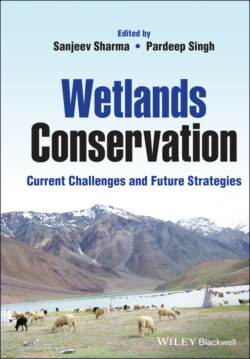Читать книгу Wetlands Conservation - Группа авторов - Страница 26
2.4 Wetland Definition and Classification
ОглавлениеThe term “wetland” represents a host of ecosystems inundated by water for a certain period of the year and possessing characteristics unique to wetland ecosystems. While there have been many definitions proposed by many scientists/researchers but the most versatile and widely accepted definition has been given by the Ramsar Convention which has taken care of every aspect of the wetlands. Article 1.1 of the Ramsar convention defines wetlands as “the areas of marsh, fen, peatland or water, whether natural or artificial, permanent or temporary, with water that is static or flowing, fresh, brackish or salt, including areas of marine water the depth of which at low tide does not exceed 6 m.” Article 2.1 further states that “the riparian and coastal zone adjacent to the wetlands and islands or bodies of marine water deeper than six meters at low tide” may also be considered as wetlands. The typology of wetland accepted by the Ramsar Convention (which also accompanies the Ramsar definition) incorporates the three attributes to describe 42 different types of habitats across coastal/marine and inland environments (Table 2.1). These typologies also include streams, rivers, caves, coral reefs, alpine meadows, springs, dams, wastewater treatment areas as well as the more traditionally considered marshes and swamps (Ramsar Convention Secretariat 2011).
Table 2.1 Ramsar classification system for wetland types.
| Marine/Coastal Wetlands | |
| A | Permanent shallow marine waters; in most cases, less than 6 m deep at low tide; includes sea bays and straits |
| B | Marine subtidal aquatic beds; includes kelp beds, sea‐grass beds, and tropical marine meadows |
| C | Coral reefs |
| D | Rocky marine shores; includes rocky offshore islands and sea cliffs |
| E | Sand, shingle, or pebble shores; includes sand bars, spits, and sandy islets; includes dune systems and humid dune slacks |
| F | Estuarine waters; permanent water of estuaries and estuarine systems of deltas |
| G | Intertidal mud, sand, or salt flats |
| H | Intertidal marshes; includes salt marshes, salt meadows, saltings, raised salt marshes; includes tidal brackish and freshwater marshes |
| I | Intertidal forested wetlands; includes mangrove swamps, Nipah swamps and tidal freshwater swamp forests |
| J | Coastal brackish/saline lagoons; brackish to saline lagoons with at least one relatively narrow connection to the sea |
| K | Coastal freshwater lagoons; includes freshwater delta lagoons |
| Zk (a) | Karst and other subterranean hydrological systems, marine/coastal |
| Inland Wetlands | |
| L | Permanent inland deltas |
| M | Permanent rivers/streams/creeks; includes waterfalls |
| N | Seasonal/intermittent/irregular rivers/streams/creeks |
| O | Permanent freshwater lakes (over 8 ha); includes large oxbow lakes |
| P | Seasonal/intermittent freshwater lakes (over 8 ha); includes floodplain lakes |
| Q | Permanent saline/brackish/alkaline lakes |
| R | Seasonal/intermittent saline/brackish/alkaline lakes and flats |
| Sp | Permanent saline/brackish/alkaline marshes/pools |
| Ss | Seasonal/intermittent saline/brackish/alkaline marshes/pools |
| Tp | Permanent freshwater marshes/pools; ponds (below 8 ha), marshes, and swamps on inorganic soils; with emergent vegetation water‐logged for at least most of the growing season |
| Ts | Seasonal/intermittent freshwater marshes/pools on inorganic soils; includes sloughs, potholes, seasonally flooded meadows, and sedge marshes |
| U | Non‐forested peatlands; includes shrub or open bogs, swamps, and fens |
| Va | Alpine wetlands; includes alpine meadows and temporary waters from snowmelt |
| Vt | Tundra wetlands; includes tundra pools and temporary waters from snowmelt |
| W | Shrub‐dominated wetlands; shrub swamps, shrub‐dominated freshwater marshes, shrub‐carr, and alder thicket on inorganic soils |
| Xf | Freshwater, tree‐dominated wetlands; includes freshwater swamp forests, seasonally flooded forests, and wooded swamps on inorganic soils |
| Xp | Forested peatlands; peat‐swamp forests |
| Y | Freshwater springs; oases |
| Zg | Geothermal wetlands |
| Zk (b) | Karst and other subterranean hydrological systems, inland |
| Human‐made Wetlands | |
| 1. | Aquaculture (e.g. fish/shrimp) ponds |
| 2. | Ponds; includes farm ponds, stock ponds, and small tanks (generally below 8 ha) |
| 3. | Irrigated land; includes irrigation channels and rice fields |
| 4. | Seasonally flooded agricultural land (including intensively managed or grazed wet meadow or pasture) |
| 5. | Salt exploitation sites; salt pans, salines, etc. |
| 6. | Water storage areas; reservoirs/barrages/dams/impoundments (generally over 8 ha) |
| 7. | Excavations; gravel/brick/clay pits; borrow pits, mining pools |
| 8. | Wastewater treatment areas; sewage farms, settling ponds, oxidation basins, etc. |
| 9. | Canals and drainage channels, ditches |
| Zk (c) | Karst and other subterranean hydrological systems, human‐made |
The Ramsar Convention has adopted a Ramsar Classification for wetland types (Table 2.1) which includes 42 types, grouped into three categories: Marine and Coastal Wetlands, Inland Wetlands, and Human‐made Wetlands. The marine wetlands are considered to be wetlands up to a depth of 6 m at low tide (and this depth is believed to be the maximum depth to which various sea ducks can dive during feeding). The treaty also includes waters deeper than 6 m, as well as islands, within the boundaries of protected wetlands. The lakes and rivers are understood to be covered by the Ramsar definition of wetlands in their entirety, regardless of their depth (Ramsar Convention Secretariat 2010, 2011).
